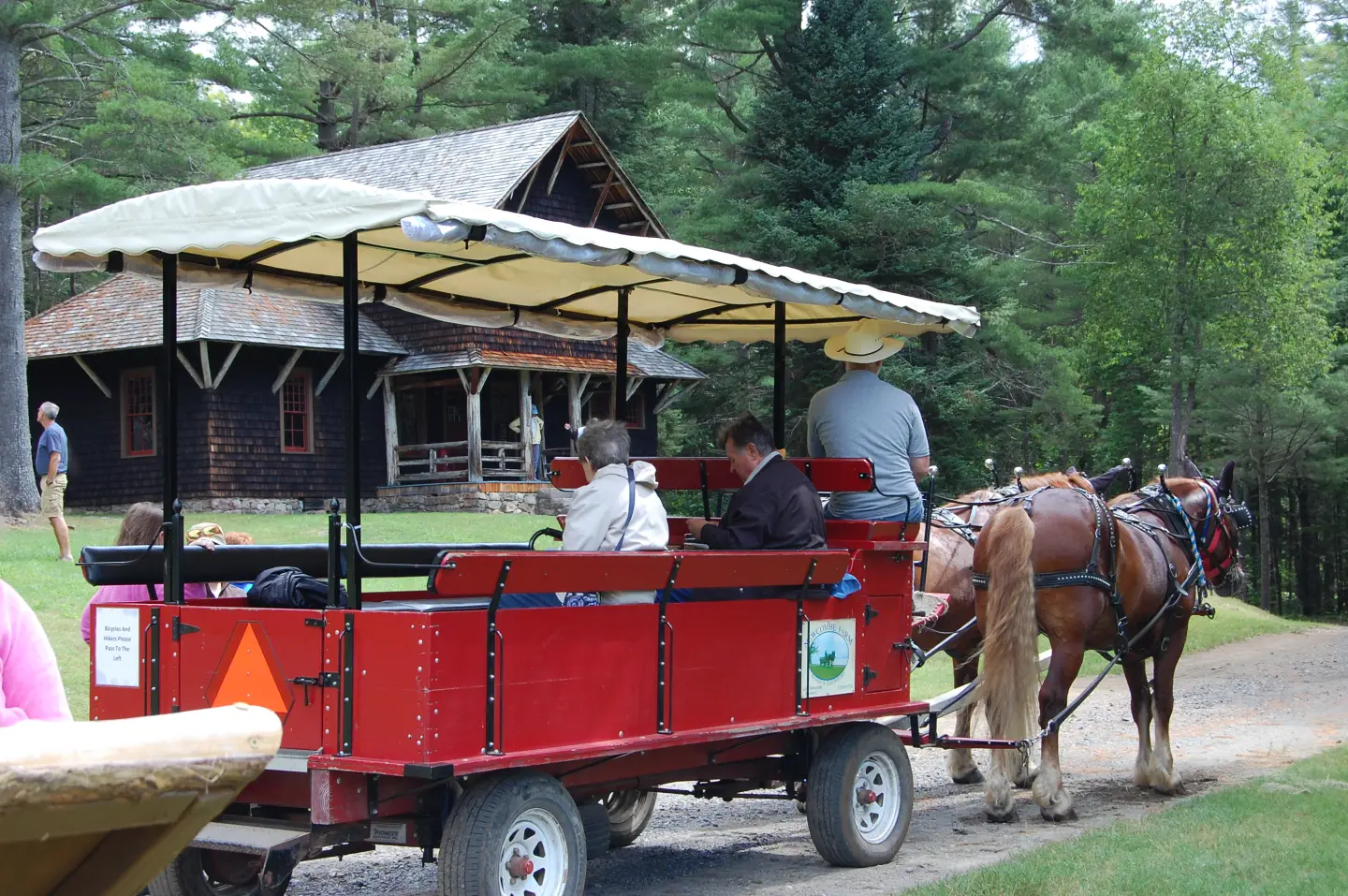Who knew that unique Japanese-influenced architecture, a National Historic Landmark and an Adirondack mystery are rolled into one Great Camp five miles back from the nearest road in the town of Newcomb? The only way to access Camp Santanoni is on foot, by bike, cross country skiing in the winter or riding a horse drawn wagon. I’ve biked in before and skied partway, but this time I opted to let the horses do the work while I enjoyed a ride in the covered wagon.
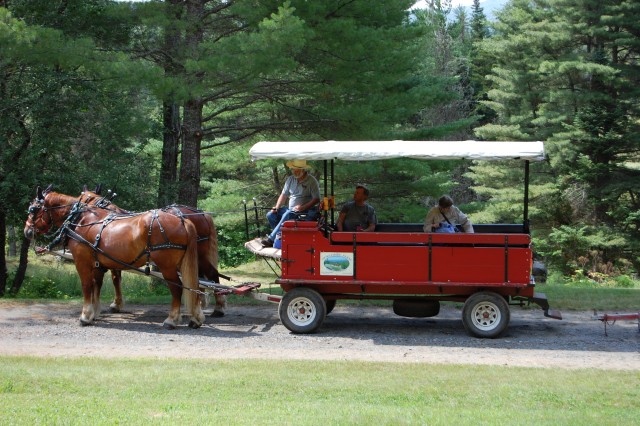
Newcombe Farm, owned by Larry and Pam Newcombe, is in its second season of transporting people into the Great Camp on a daily basis, weather permitting. They ask that folks call ahead for a reservation (518-639-5534 or 518-480-1743) and they are able to accommodate anyone. They even have a wheelchair lift equipped wagon but they do need prior notice if it needs to be used. They charge $25 per person for the 10 mile round trip ride, but anyone over 62 or physically unable to make the trip on their own are free. According to Larry, they are able to provide this through a grant from the State of New York to insure compliance with the Americans With Disabilities Act.
I had family visiting from out of the area, including my snowbird parents and my Long Island-based sister and her three kids. I thought spending a day at Santanoni would be an interesting trip for everyone. I was not disappointed. It was a real work day for the horses as the wagon was full with 12 riders, my nieces sharing the bench seat up front with Larry, and two more adults, two children and a dog riding in the trailer behind the wagon. The trailer also carried coolers, a tackle box and two canoes with paddles.
On Our Way!
Our journey began just after 10 a.m. from the Gatehouse complex of the camp. It’s a good idea to browse through the Gatehouse for a quick overview of the historical camp before starting your trip. There you’ll learn the Camp was originally built for the Pruyn family of Albany in the late 1800s. Robert Pruyn was a wealthy banker who wanted a “gentleman’s farm” in the country. His wife, Anna, wanted a lakeside rustic retreat. The resulting Great Camp Santanoni was their compromise. We didn’t have to read all this at the Gatehouse on our trip though, because we were fortunate enough to have Emma, an intern at Santanoni, on the wagon with us. She gave us a tour of the farm complex and around the Main Camp when we reached it.
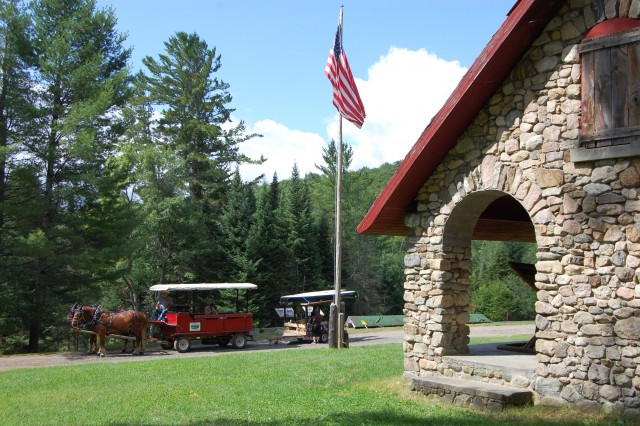
The farm complex, a mile from the parking lot, was our first stop. In keeping with Robert’s dream of a “gentleman’s farm” everything the family needed for the self-sustaining camp was grown or raised here. In fact, the farm sometimes had such a productive growing season the Pruyns would send the fruits of their labors down to their home in Albany via an 11-hour wagon ride. The food reached Albany much more quickly after the automobile came into their lives. Emma pointed out the complex’s remaining buildings, including a creamery, the farm manager’s house, a smokehouse (in the woods - you have to look for that one) and other assorted service buildings, as well as the foundation of the barn which burned in 2004.
We explored on our own for a short while before climbing back into the wagon. The road through the property was a little bumpy, but very scenic and noticeably increasing in elevation as we neared our final destination. The gradual ascent is much more pronounced when my legs are pumping the bike pedals and not resting in a horse drawn carriage!
Just minutes before reaching the Main Lodge, we slowed down at a bridge with water on both sides. The left side is Newcomb Lake, the right is Duck Hole. There are eight designated campsites around the Main Camp complex and the first few are on the Newcomb Lake side of the road. If you want to camp in this remote location for a few days, maybe bring in a canoe or some kayaks along with your gear, you can arrange with Larry to haul everything in for you and come back whenever you want to be picked up.
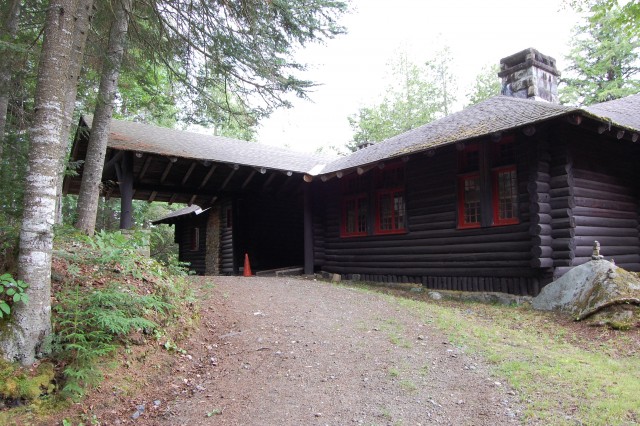
The Main Lodge
We pulled up to the impressive log buildings right around noon. Larry pointed out what we needed to know the most – the direction of the outhouse – and we were left to walk around for the next two hours. The Great Camp is located on the shore of Newcomb Lake. Robert Pruyn had spent several years of his youth in Japan and was influenced by the culture. He hired an architect who would incorporate Japanese influences in the design of the main lodge, notably in the “great roof” which is one continuous roof over all the separate buildings. From the air, the design is intended to resemble the mythological Phoenix in flight. The main lodge also faces west, believed to be a sign of enlightenment.
Each building within the main lodge had an intended purpose – from the bachelor and bachelorette quarters for visiting guests, to the rooms for the Pruyn family members, to the large center building which housed the great room and dining room. A massive stone fireplace is the centerpiece of this building, which features birch wallpaper, multi-paned windows facing the lake, and doors adorned with medium sized twigs. The continuous roof covers a deck walkway leading to the kitchen, which was fairly modern for the 1900s, and would be the “tail” of the aerial bird’s eye view.
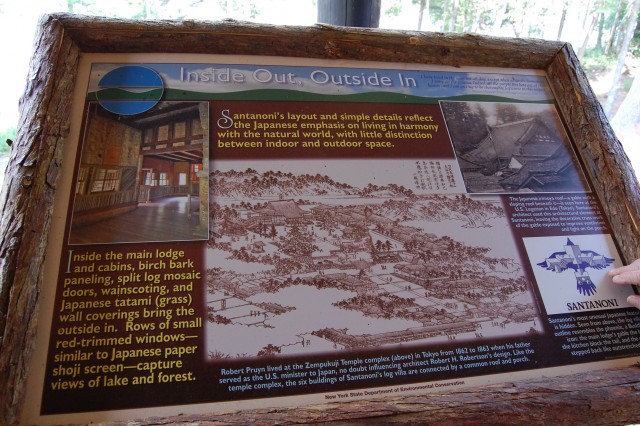
We left our cooler on one of the picnic tables on the deck facing the water and set off to discover the property. The first building we visited, off to the south of the Great Camp, was the boathouse. There are several boats, paddles and life jackets available for use. I suspect the aluminum canoes and modern day kayaks were not part of the original fleet. It was pretty windy the day we were there and the water looked choppy so we opted not to venture out onto the lake. We did take advantage of the cool day to follow a trail around the north side of the lake, past the artist’s studio that was built for the Pruyn’s son, to a four stall bathhouse set on a very small beach. The rest of the primitive campsites are along this stretch of the lake as well. A loop around the entire lake is 4.2 miles.
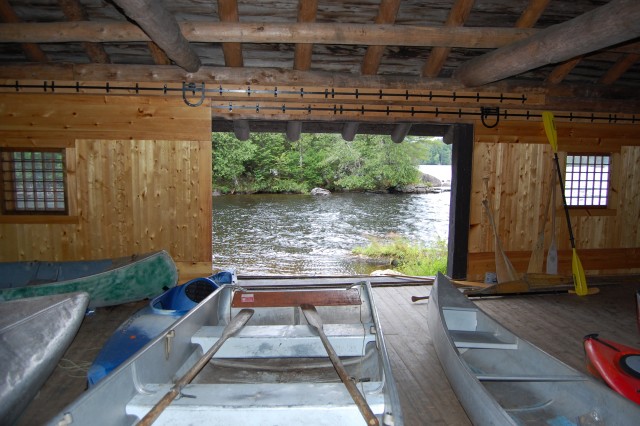
We returned from exploring in time to enjoy our picnic lunch and listen to Emma’s presentation about the history of this fascinating place. All of the logs used to build the camp were harvested from trees on site. The Pruyn family preferred smaller, more intimate groups of people but that’s not to say they didn’t entertain. They were a prominent family who hosted the likes of Theodore Roosevelt, James Fenimore Cooper and other notable people from history.
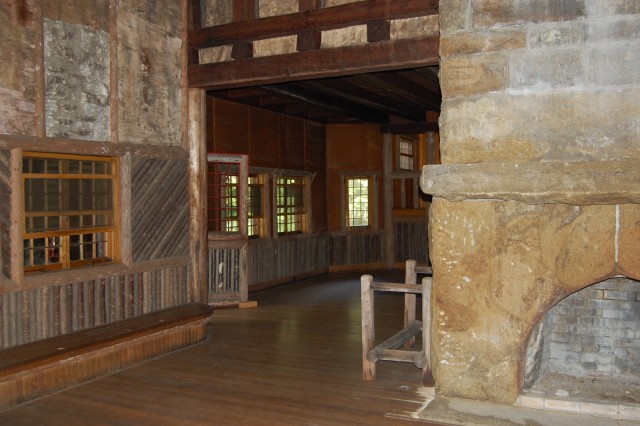
A Boy Disappears
In the mid-1950s, heirs of the Pruyns sold the Great Camp to the Melvin brothers from Syracuse. The brothers and their families enjoyed their Adirondack retreat until 1971 when one of their grandchildren, Douglas Legg, disappeared without a trace from around the Main Lodge. Accounts of the last time he was seen vary. His uncle told one story the day of the disappearance and changed it days later. Douglas’ brother gave another version when their mother finally allowed investigators to question the child. No remains of Douglas were ever found after a massive manhunt and the truth of his disappearance remains a mystery.
After Douglas Legg vanished, his family wanted nothing more to do with Santanoni. A year later, the State acquired the property. For almost 20 years the Great Camp sat while the State decided what to do with it. Since it’s in the State Forest Preserve, would the “Forever Wild” clause require the buildings be taken down? Thankfully, a group of interested parties proposed to the State that the Great Camp be preserved as a historic area and the idea was adopted. Santanoni is also a National Historic Landmark.
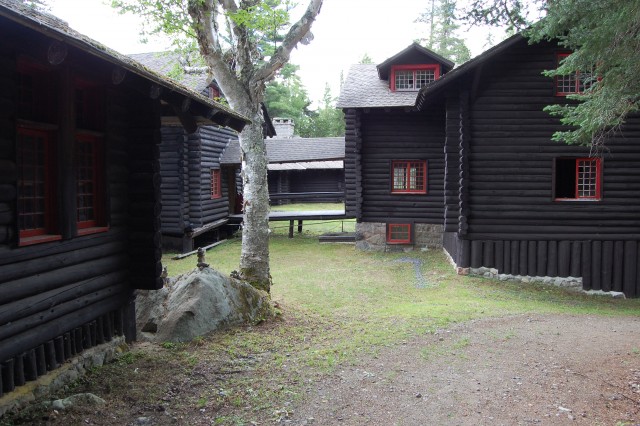
Like the mythological Phoenix that rose from the ashes, Santanoni has not only remained intact, it has been given a new lease on life over the last two decades. Through a cooperative effort by the Town of Newcomb, DEC and Adirondack Architectural Heritage, there has been funding for a variety of renovation projects. A local master carpenter works on many projects around the Main Lodge, and each summer architectural students contribute their talents toward restoration of different parts of the camp. Over the last decade, I’ve personally watched as the boathouse was restored and almost all of the individual panes in the Main Lodge’s many buildings have been lovingly re-glazed. Informational kiosks have also been added throughout the property. The transformation has been wonderful to see. The complex may be shaped like a bird, but it really is more like a jewel.
Our return trip was shorter than the ride in because we didn’t stop at the farm complex. Although we only traveled five miles back to our cars, it felt more like we journeyed through a century.
Ready to visit? Plan a stay in the Schroon Lake Region and put this Great Camp on your must-visit list!
